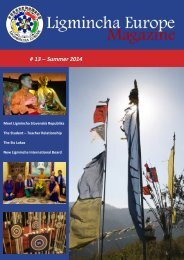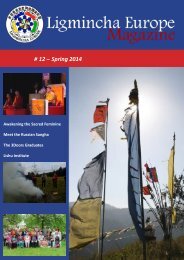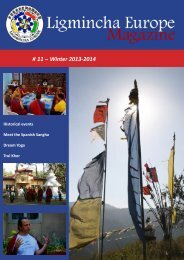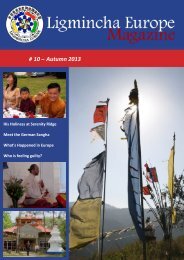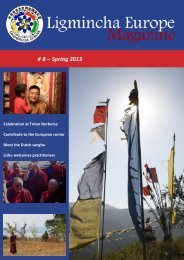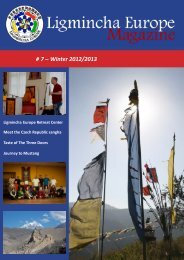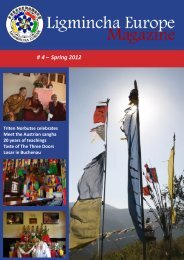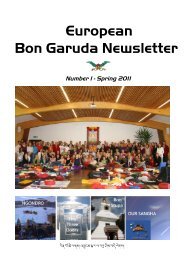Ligmincha Europe Magazine # 9 – Summer 2013
European Magazine of the Ligmincha Sangha of Tenzin Wangyal Rinpoche. Informs about news, events, teachings and projects within the Bon-Buddhist Sangha.
European Magazine of the Ligmincha Sangha of Tenzin Wangyal Rinpoche. Informs about news, events, teachings and projects within the Bon-Buddhist Sangha.
Create successful ePaper yourself
Turn your PDF publications into a flip-book with our unique Google optimized e-Paper software.
Phase 2: Recognizing rigpa<br />
What can you expect as a result of this long and<br />
arduous training in the preliminary practices?<br />
Tsoknyi Rinpoche, a contemporary Dzogchen<br />
master (13, p. 141) formulates it this way: “(...) the<br />
ngöndro training creates tremendous merit, which<br />
makes recognizing rigpa almost unavoidable. That<br />
is what merit does. You almost have no other<br />
choice than to recognize rigpa (...)”<br />
John Myrdhin Reynolds makes a clear distinction<br />
between two kinds of transmission from a<br />
Dzogchen master when working on the actual<br />
experience of rigpa (14): “In general, the Ngöndro<br />
represents a preparation designed to purify one's<br />
mind stream so that it becomes a suitable clean<br />
vessel to receive the full transmission from the<br />
master of the Dzogchen teachings. (...) The initial<br />
transmission includes a pointing out or direct<br />
introduction to the Natural State of the Nature of<br />
Mind and its intrinsic Awareness (rig-pa) in its<br />
nakedness, free of discursive thoughts and the<br />
normal conventional operations of the mind or the<br />
thought process.”<br />
The direct introduction to the state of rigpa is<br />
given by a fully qualified master. In a monastery<br />
the monks receive this transmission after having<br />
finished the Ngondro. The direct introduction into<br />
the Nature of Mind is in the second ZZNG year.<br />
Part-time practicing western laypersons have not<br />
finished the Ngondro by then.<br />
Phase 3: Getting confidence in this State<br />
After years of training you might think the first<br />
recognition of rigpa in ‘actuality’ is the endpoint<br />
of your meditation. But it is not. It is only the<br />
starting point of the Dzogchen practice and study.<br />
So in an indefinite number of years training we get<br />
confidence in rigpa. Adeu Rinpoche expresses it<br />
this way (15): “Recognizing rigpa is only the<br />
beginning of the Dzogchen path. We need to<br />
follow through and it requires a lot of<br />
perseverance. Giving the pointing-out instruction<br />
is like pointing to the ground and saying, “This is<br />
the road to Lhasa.” If you just stand there, you will<br />
never get to Lhasa.”<br />
According to an instruction from a talk by H.E.<br />
Yongdzin Tenzin Namdak Rinpoche about the<br />
Natural State: “We must discover the Natural<br />
State of Rigpa within ourselves over and over<br />
again, so that we have no doubt about it.”<br />
The Teacher and the Dharma<br />
The last phase of Dzogchen<br />
But when this Ngondro training is finally successful<br />
and the internal and external signs appear, you<br />
are ready for the ‘offering’ of your experience to<br />
your master and to receive the full transmission<br />
from him. When such an experience happens you<br />
can go on the road, with the main Dzogchen practices<br />
of Trekchö and Thögel (1, ch. 15) for the rest<br />
of your life, on the shortest and highest Buddhist<br />
path: liberation in one single life. The Experiential<br />
Transmission of Zhang Zhung, or Zhang Zhung<br />
Nyen Gyud is such a precious path.<br />
In conclusion<br />
Dzogchen as a lifelong learning process is clearly<br />
summarized by Patrul Rinpoche (12, p. 256): “Of<br />
all that we perceive as forms and sounds there is<br />
nothing that does not arise from the mind. To<br />
realize that the mind is awareness indivisible from<br />
emptiness is the view. Keeping this realization in<br />
mind at all times, and never being distracted from<br />
it, is meditation. To practice the two accumulations<br />
as magical illusion from within that state is<br />
action. If you make a living experience of this practice,<br />
it will continue in your dreams. If it comes in<br />
the dream state, it will come at the moment of<br />
death. And if it comes at the moment of death it<br />
will come in the intermediate state. If it comes in<br />
the intermediate state you may be certain of<br />
attaining supreme accomplishment.”<br />
H.E. Yongdzin Tenzin Namdak Rinpoche<br />
© Elisabeth Egon Viebre<br />
page<br />
31






